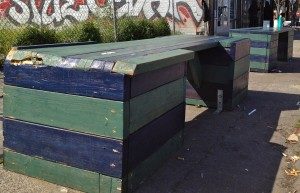(First published on Project Oakland on March 28, 2012)
Social struggles occur in diverse places in Oakland: at street protests, in debates at City Hall, and sometimes even where you plant your butt! Take the benches in this photo: though modest and unassuming, they are actually a salvo in the battles over public space that are presently unfolding in Oakland and cities worldwide.
 They sit steps from a West Oakland park known as a hangout for the homeless and super-poor. At this park, it is common to see a half-dozen shopping carts full of belongings, people drinking from paper bags, and to smell pot smoke wafting through the air. Those present are almost always black men, middle-aged and up, with a sprinkling of younger adults and women of assorted ages. I have only seen kids there twice during the dozens of times that I have passed by and the absence of swings or play gear of any sort suggests that no one expects them to show up more regularly. I have never witnessed the police harassing people there, though surely it would not be hard for them to come up with reasons to do so if they wished. It appears that authorities have decided that it is okay for the uber-marginalized to congregate at this site. Something similar would not be allowed in Berkeley or San Francisco, which rank among the “meanest” cities to the homeless in the United States.
They sit steps from a West Oakland park known as a hangout for the homeless and super-poor. At this park, it is common to see a half-dozen shopping carts full of belongings, people drinking from paper bags, and to smell pot smoke wafting through the air. Those present are almost always black men, middle-aged and up, with a sprinkling of younger adults and women of assorted ages. I have only seen kids there twice during the dozens of times that I have passed by and the absence of swings or play gear of any sort suggests that no one expects them to show up more regularly. I have never witnessed the police harassing people there, though surely it would not be hard for them to come up with reasons to do so if they wished. It appears that authorities have decided that it is okay for the uber-marginalized to congregate at this site. Something similar would not be allowed in Berkeley or San Francisco, which rank among the “meanest” cities to the homeless in the United States.
An inspection of these benches yields insights into their origins (click the photo above for a larger view). First of all, we can see that they are not city-issue products. Local authorities construct benches out of steel, or a mix of steel and composite wood, whereas these are simply painted wooden planks bolted to the sidewalk with cheap “L” brackets. We can also conclude that they are not the work of a business hoping to accommodate its customers—they lie in front of a trash-strewn lot, not a store or restaurant. Everything indicates that some guerrilla decorators installed them surreptitiously, presumably under the cloak of night and inspired by the outrageous thought that poor people also have a right to sit down.
The built environment is inherently political. This is obvious in the case of things like monuments and palaces, but seating and politics also have a particularly strong connection. In Home: A Short History of An Idea, Witold Rybcznski sketches the long evolution of approaches to seating and argues that what has changed over the years is less the technology of seating than its cultural use. He points out that seats are often means of articulating and representing power. We see hints of this in our everyday language: the head of an academic department is the “chair,” a judge “sits” on “the bench,” the center of authority in a country is the “seat” of power, a monarch occupies “the throne,” etc.
But what does it mean when someone covertly builds seats for the marginalized in a city like Oakland, with its vast quantities of public space that have been privatized and in which thousands have been stripped of their right to assemble due to encounters with the Prison Industrial Complex? It is an act of compassion and also an act of resistance. To write the needs of the impoverished into the physical structure of the city itself, even in a small way, is a gesture toward reclaiming public space, toward reopening the commons.
Changing society and changing our practices of domesticity and comfort have always gone hand in hand. The Black Panther Party housed its members in austere, barrack-like “Panther pads,” whereas hippies built kaleidoscopic homes in the form of geodesic domes—their larger social visions influenced their sense of space and decor, and vice versa. Whatever forms we might invent in the future, these benches point to a politics of seating in which the purpose of seats is not to bolster authority and coercion but to recuperate the city for the oppressed. While plain and easy to overlook, they are among the many signs that rebellion is alive and well in Oakland.
~ Chuck Morse
